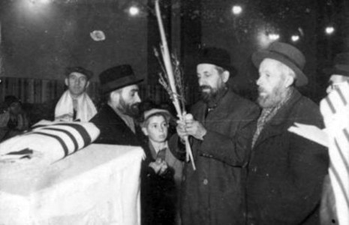By Anav Silverman

A series of photos documenting the observance of Sukkot in Ghetto Lodz in 1941 were recently revealed by the Shem Olam Institute, also known as the Faith and the Holocaust Institute for Education Documentation and Research in Kfar Haroeh.
The photos show the ghetto’s Jewish occupants praying with the four species; the etrog (citron), and the lulav, hadas and aravah, (palm, willow and myrtle) required for Sukkot as well as having built a sukkah, the special temporary dwelling for eating and sleeping throughout the seven-day holiday.
It was no easy task for the ghetto residents to obtain two sets of the four species in order to properly celebrate Sukkot in 1941, according to Rabbi Avraham Krieger, the director of the Shem Olam Institute. “To find an etrog was extremely rare during this time in Poland and especially in the ghetto at the height of WWII,” said Rabbi Krieger in a report about the photos by Israel’s NRG news.
The Nazis had decreed that Jews would be forced to live in closed off and cramped areas known as ghettos once Germany invaded Poland in 1939, until the Nazis decided what would be done with the Jewish population. In February 1940, the order to establish the Lodz ghetto was passed and Jews throughout the city were forced to move in.
According to Krieger, the etrogim may have been smuggled into the ghetto after a long journey from Israel or Greece. The leader of the Jewish ghetto, Mordechai Chaim Rumkowski gave special permission for a few of the ghetto’s Jewish residents to travel to Warsaw and try to locate the four species, which were almost impossible to find in Eastern Europe at the time.
Once the four species reached the ghetto, Jewish residents waited in long lines in order to bless them. A letter of thanks to Rumkowski sent from the Gur Hassidim of the ghetto – dated September 1941 -expressed the residents’ appreciation for blessing the four species and the joy they felt for being able to do so.
Likewise, explains Krieger, building a sukkah was a difficult feat as well at the time. “The ghetto was in a constant state of crisis for materials to keep the people warm. Every piece of wood for fire was needed, including doors and window frames. Therefore in order to build a sukkah, the people needed special permission to retain the wood for this purpose.”
The Shem Olam Institute was established in 1996 by Rabb Krieger to document and share the issues of faith and survival during the Holocaust. The institute has more than 800,000 documents and exhibits that share the world of Jewish faith and spirit in the Holocaust.
*
Previous provided by Tazpit News Agency